The Impact of High-Speed and Thermal-Assisted Machining on Tool Wear and Surface Roughness during Milling of SKD11 Steel
Abstract
1. Introduction
2. Methodology
2.1. Material
2.2. Experimental Setup
3. Results and Discussions
3.1. Influence of the TAM Process on Cutting-Tool Wear during High-Speed Milling of SKD11
3.2. Influence of the High-Speed Cutting on Tool Wear in TAM Process for SKD11 Steel
3.3. Influence of TAM Process and High-Speed Cutting on Surface Roughness during Milling of SKD11 Steel
3.4. Relationship between Surface Roughness and Cutting-Tool Wear during High-Speed Machining and TAM Process for SKD11 Steel
4. Conclusions
- -
- The heating process is an effective and economical method for supporting milling with low-cost non-carbide-coated cutting tools.
- -
- Tool wear decreases as TAM temperature increases during the machining process, and increases with increasing cutting speed. Wear rates are relatively uniform between cutting speeds of 600 m/min to 900 m/min, with faster wear rates observed at speeds greater than 900 m/min.
- -
- Surface roughness decreases with increasing TAM temperature during the milling process. The roughness initially increases with increasing cutting speed between 600 m/min and 800 m/min but decreases as the cutting speed continues to increase.
- -
- The amount of wear height has a clear impact on surface roughness during high-speed machining with a TAM of SKD11 steel. However, when the cutting speed exceeds 800 m/min, the effect of cutting speed on surface roughness becomes more pronounced than the impact of tool wear under the same TAM temperature of 500 °C, even though the tool wear rate increases significantly at high cutting speeds.
- -
- To achieve optimal surface quality, we recommend using a milling mode with a cutting speed of 600 m/min at 500 °C. However, for higher material removal speed and reduced machining time, a cutting speed of 1000 m/min and a TAM temperature of 500 °C are ideal, while still achieving low surface roughness under these conditions.
Author Contributions
Funding
Data Availability Statement
Acknowledgments
Conflicts of Interest
References
- Liu, Z.; Ai, X.; Zhang, H.; Wang, Z.; Wan, Y. Wear patterns and mechanisms of cutting tools in high-speed face milling. J. Mater. Process. Technol. 2002, 129, 222–226. [Google Scholar] [CrossRef]
- Khan, S.A.; Ameer, M.F.; Uddin, G.M.; Ali, M.A.; Anwar, S.; Farooq, M.U.; Alfaify, A. An in-depth analysis of tool wear mechanisms and surface integrity during high-speed hard turning of AISI D2 steel via novel inserts. Int. J. Adv. Manuf. Technol. 2022, 122, 4013–4028. [Google Scholar] [CrossRef]
- Baig, A.; Jaffery, S.H.I.; Khan, M.A.; Alruqi, M. Statistical Analysis of Surface Roughness, Burr Formation and Tool Wear in High Speed Micro Milling of Inconel 600 Alloy under Cryogenic, Wet and Dry Conditions. Micromachines 2023, 14, 13. [Google Scholar] [CrossRef] [PubMed]
- Thi-Hoa, P.; Thi-Bich, M.; Van-Canh, T.; Tien-Long, B.; Duc-Toan, N. A study on the cutting force and chip shrinkage coefficient in high-speed milling of A6061 aluminum alloy. Int. J. Adv. Manuf. Technol. 2018, 98, 177–188. [Google Scholar] [CrossRef]
- del Olmo, A.; de Lacalle, L.L.; de Pissón, G.M.; Pérez-Salinas, C.; Ealo, J.; Sastoque, L.; Fernandes, M. Tool wear monitoring of high-speed broaching process with carbide tools to reduce production errors. Mech. Syst. Signal Process. 2022, 172, 109003. [Google Scholar] [CrossRef]
- Lezanski, P.; Shaw, M.C. Tool face temperatures in high speed milling. J. Eng. Ind. 1990, 112, 132–135. [Google Scholar] [CrossRef]
- Tian, X.; Zhao, J.; Zhao, J.; Gong, Z.; Dong, Y. Effect of cutting speed on cutting forces and wear mechanisms in high-speed face milling of Inconel 718 with Sialon ceramic tools. Int. J. Adv. Manuf. Technol. 2013, 69, 2669–2678. [Google Scholar] [CrossRef]
- Irving, A.D.; Clarance, L.M.; Russell, F.H. High Temperature Machining Methods; Armed Services Techinical Information Agency, Arlington Hall Station: Arlington, VA, USA, 1963. [Google Scholar]
- Su, H.; Liu, P.; Fu, Y.; Xu, J. Tool life and surface integrity in high-speed milling of titanium alloy TA15 with PCD/PCBN tools. Chin. J. Aeronaut. 2012, 25, 784–790. [Google Scholar] [CrossRef]
- Mac, T.-B.; Luyen, T.-T.; Nguyen, D.-T. A Study for Improved Prediction of the Cutting Force and Chip Shrinkage Coefficient during the SKD11 Alloy Steel Milling. Machines 2022, 10, 229. [Google Scholar] [CrossRef]
- Kong, X.; Dang, Z.; Liu, X.; Wang, M.; Hou, N. Simulation and Experimental Analysis of Tool Wear and Surface Roughness in Laser Assisted Machining of Titanium Alloy. Crystals 2023, 13, 40. [Google Scholar] [CrossRef]
- Jeong, H.-I.; Lee, C.-M. A study on improvement of tool life using a heat shield in laser assisted machining to Inconel 718. Opt. Laser Technol. 2021, 142, 107208. [Google Scholar] [CrossRef]
- Xavierarockiaraj, S.; Kuppan, P. Investigation of cutting forces, surface roughness and tool wear during laser assisted machining of SKD11Tool steel. Procedia Eng. 2014, 97, 1657–1666. [Google Scholar] [CrossRef]
- Thanh-Huan, N.; Duc-Toan, N. Experimental Researches of Turning Hardened 9CrSi Alloy Tool Steel with Laser-Assisted Machining. Arab. J. Sci. Eng. 2021, 46, 11725–11738. [Google Scholar] [CrossRef]
- Bijanzad, A.; Munir, T.; Abdulhamid, F. Heat-assisted machining of superalloys: A review. Int. J. Adv. Manuf. Technol. 2022, 118, 3531–3557. [Google Scholar] [CrossRef]
- Phan, N.H.; Toan, N.D.; Shailesh, S. Simultaneous improvement of Z-coordinate and overcut in EDM of titanium grade 5 alloy using a carbon-coated micro-tool electrode. Mod. Phys. Lett. B 2023, 2340004. [Google Scholar] [CrossRef]
- Özler, L.; Inan, A.; Özel, C. Theoretical and experimental determination of tool life in hot machining of austenitic manganese steel. Int. J. Mach. Tools Manuf. 2001, 41, 163–172. [Google Scholar] [CrossRef]
- Ginta, T.L.; Amin, A.N. Thermally-assisted end milling of titanium alloy Ti-6Al-4V using induction heating. Int. J. Mach. Mach. Mater. 2013, 14, 194–212. [Google Scholar] [CrossRef]
- Chang, C.-W.; Kuo, C.-P. Evaluation of surface roughness in laser-assisted machining of aluminum oxide ceramics with Taguchi method. Int. J. Mach. Tools Manuf. 2007, 47, 141–147. [Google Scholar] [CrossRef]
- Wang, R.; Yang, D.; Wang, W.; Wei, F.; Lu, Y.; Li, Y. Tool Wear in Nickel-Based Superalloy Machining: An Overview. Processes 2022, 10, 2380. [Google Scholar] [CrossRef]
- Ye, G.; Zhang, P.; Zhang, J.; Zhang, Y.; Huang, X. Study on nanometer cutting mechanism of single crystal silicon at different temperatures. J. Manuf. Process. 2023, 93, 275–286. [Google Scholar] [CrossRef]
- Germain, G.; Santo, P.D.; Lebrun, J. Comprehension of chip formation in laser assisted machining. Int. J. Mach. Tools Manuf. 2011, 51, 230–238. [Google Scholar] [CrossRef]
- Mac, T.-B.; Banh, T.-L.; Nguyen, D.-T. Study on cutting force and chip shrinkage coefficient during thermal: Assisted machining by induction heating of SKD11 steel. J. Korean Soc. Precis. Eng. 2019, 36, 803–811. [Google Scholar] [CrossRef]
- Mac, T.B.; Luyen, T.T.; Nguyen, D.T. Assessment of the Effect of Thermal-Assisted Machining on the Machinability of SKD11 Alloy Steel. Metals 2023, 13, 699. [Google Scholar] [CrossRef]
- Musavi, S.H.; Sepehrikia, M.; Davoodi, B.; Niknam, S.A. Performance analysis of developed micro-textured cutting tool in machining aluminum alloy 7075-T6: Assessment of tool wear and surface roughness. Int. J. Adv. Manuf. Technol. 2022, 119, 3343–3362. [Google Scholar] [CrossRef]
- Sommer, D.; Pape, D.; Esen, C.; Hellmann, R. Tool Wear and Milling Characteristics for Hybrid Additive Manufacturing Combining Laser Powder Bed Fusion and In Situ High-Speed Milling. Materials 2022, 15, 1236. [Google Scholar] [CrossRef]
- Ghoreishi, R.; Roohi, A.H.; Ghadikolaei, A.D. Analysis of the influence of cutting parameters on surface roughness and cutting forces in high speed face milling of Al/SiC MMC. Mater. Res. Express 2018, 5, 086521. [Google Scholar] [CrossRef]
- Dong, T.P.; Toan, N.D. A study on the investigation of the microstructure of SKD61 steel after selected quenching and tempering processes. Mod. Phys. Lett. B 2023, 2340022. [Google Scholar] [CrossRef]
- Subramanian, A.V.M.; Nachimuthu, M.D.G.; Cinnasamy, V. Assessment of cutting force and surface roughness in LM6/SiC p using response surface methodology. J. Appl. Res. Technol. 2017, 15, 283–296. [Google Scholar] [CrossRef]
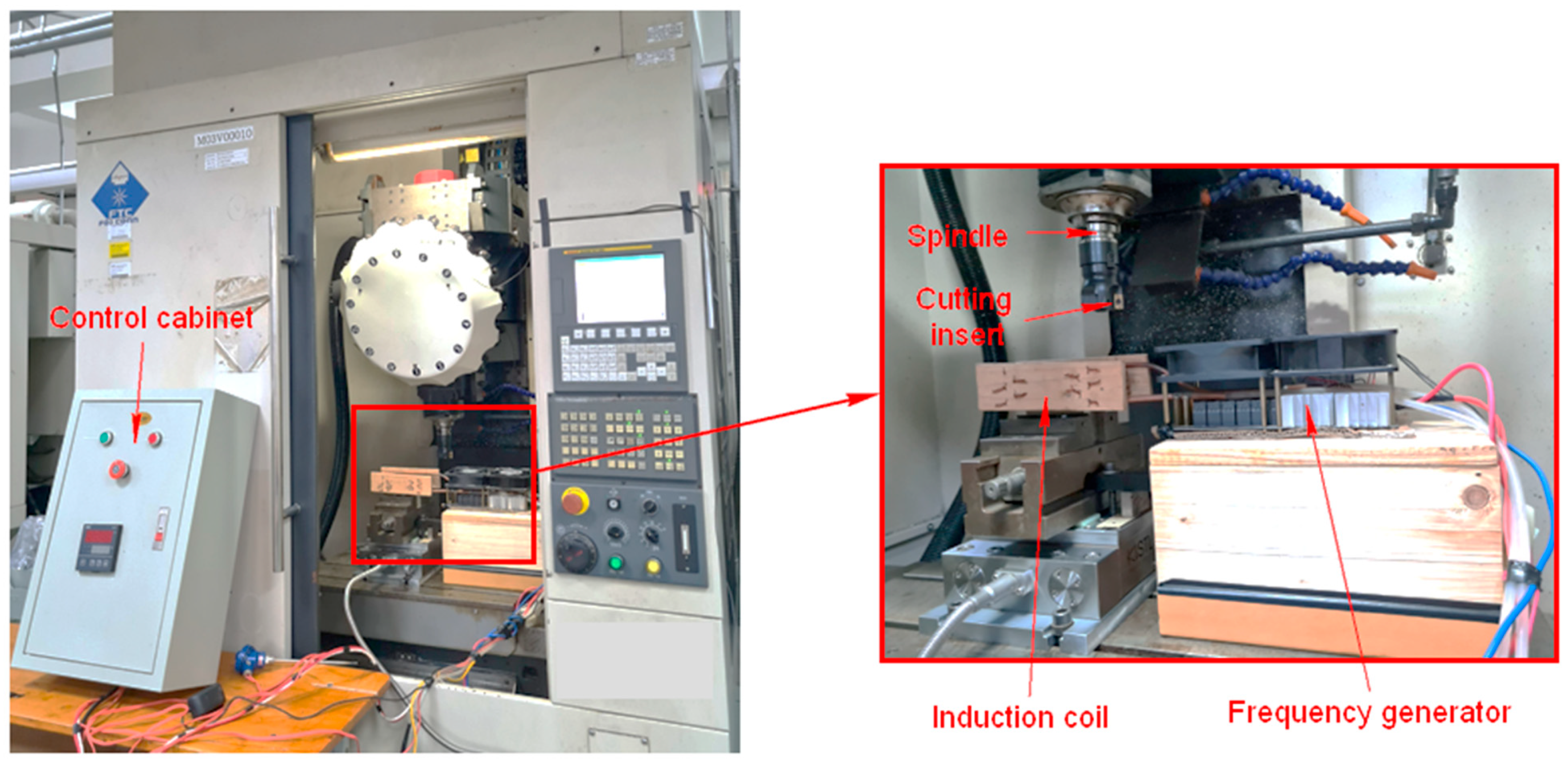

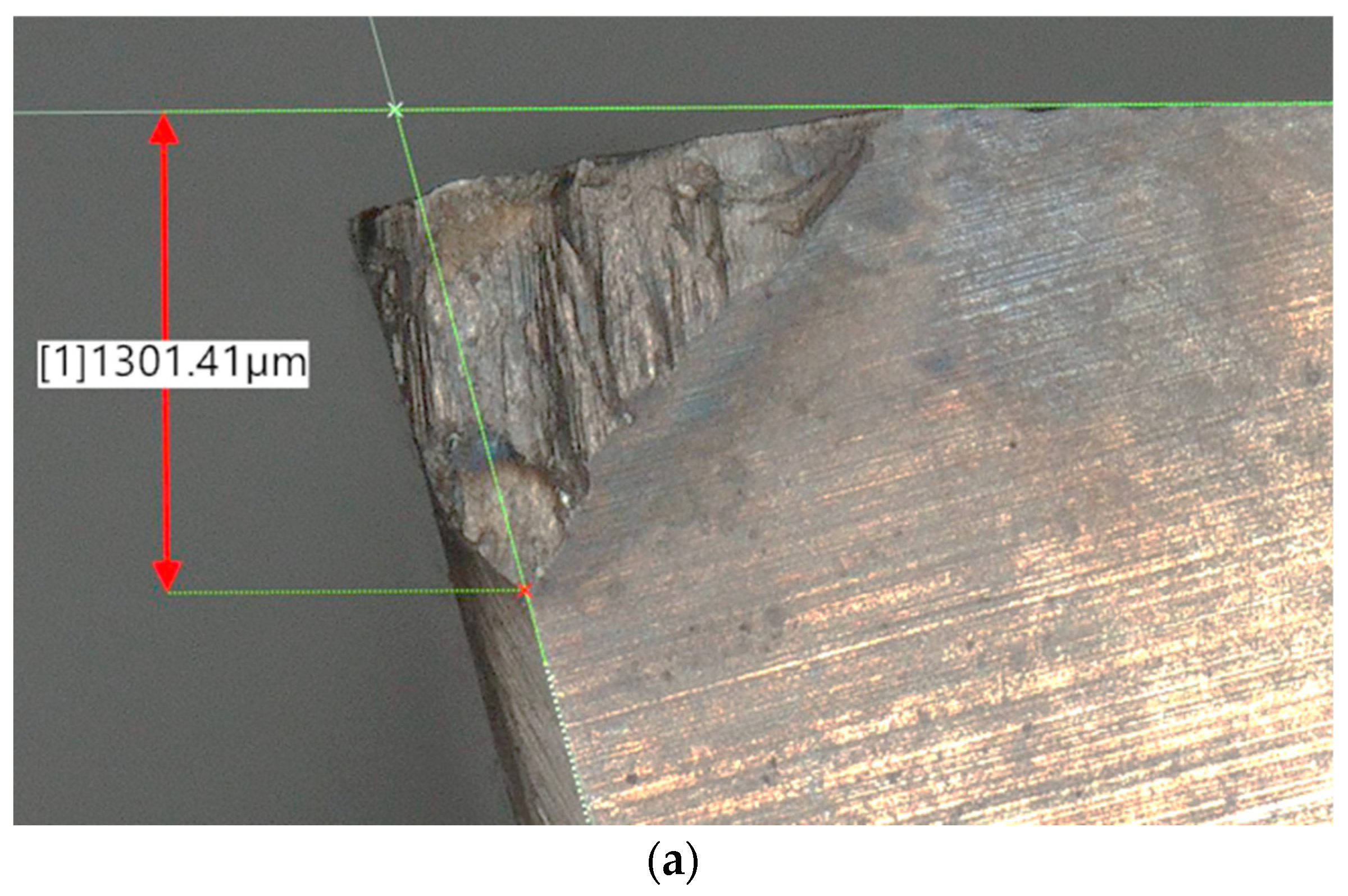


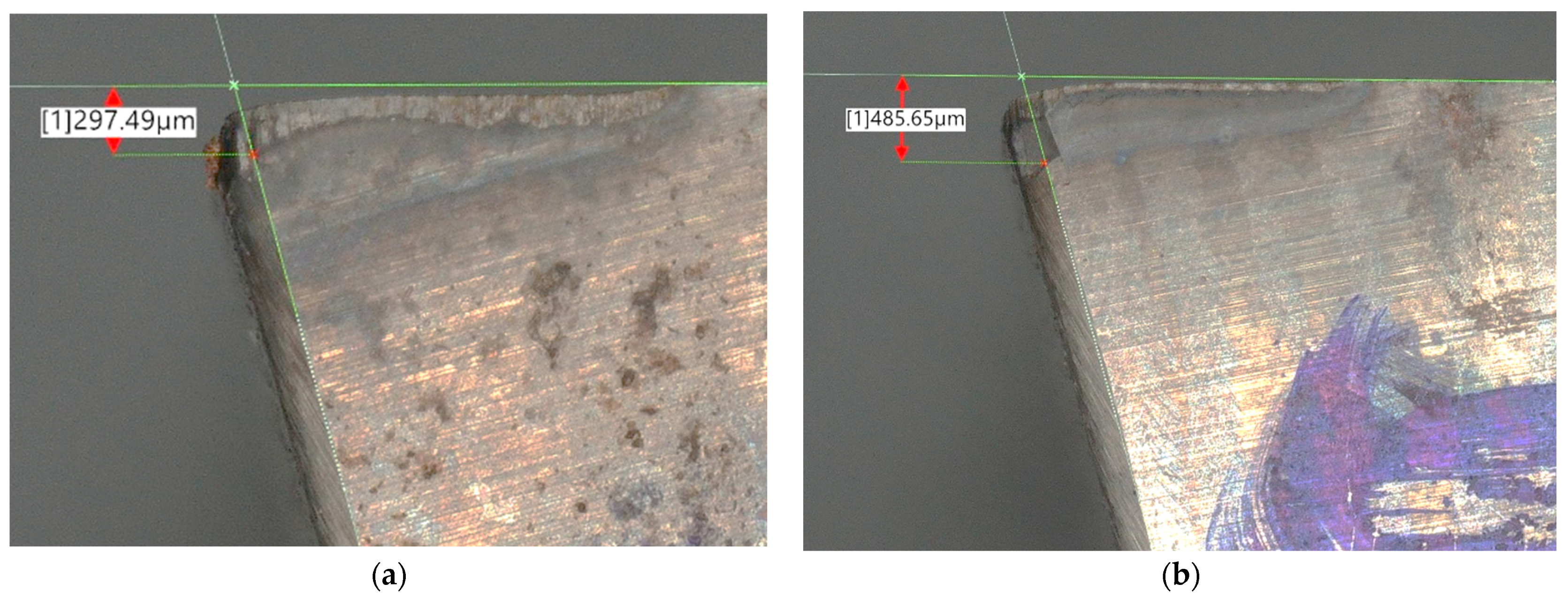
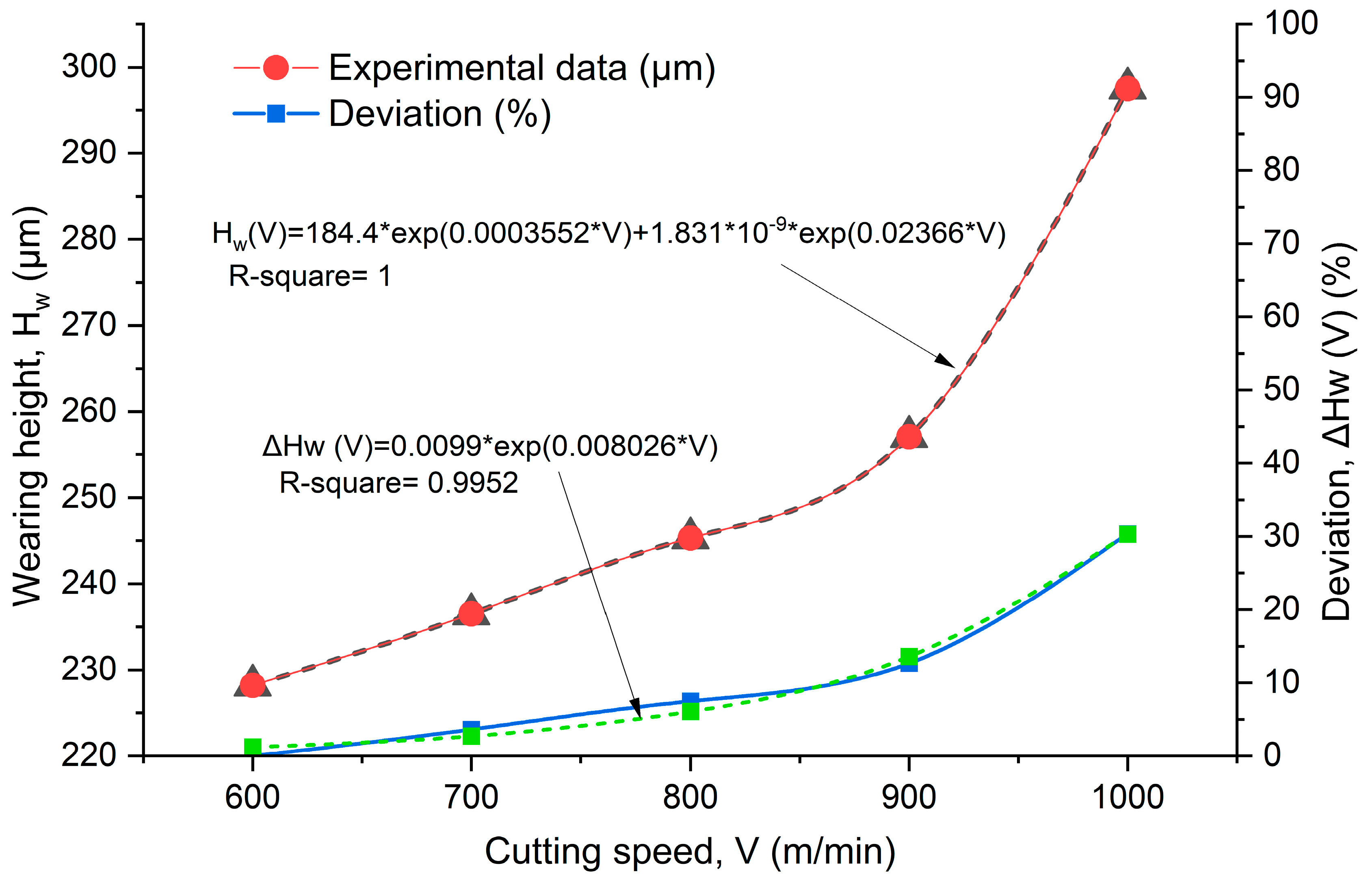
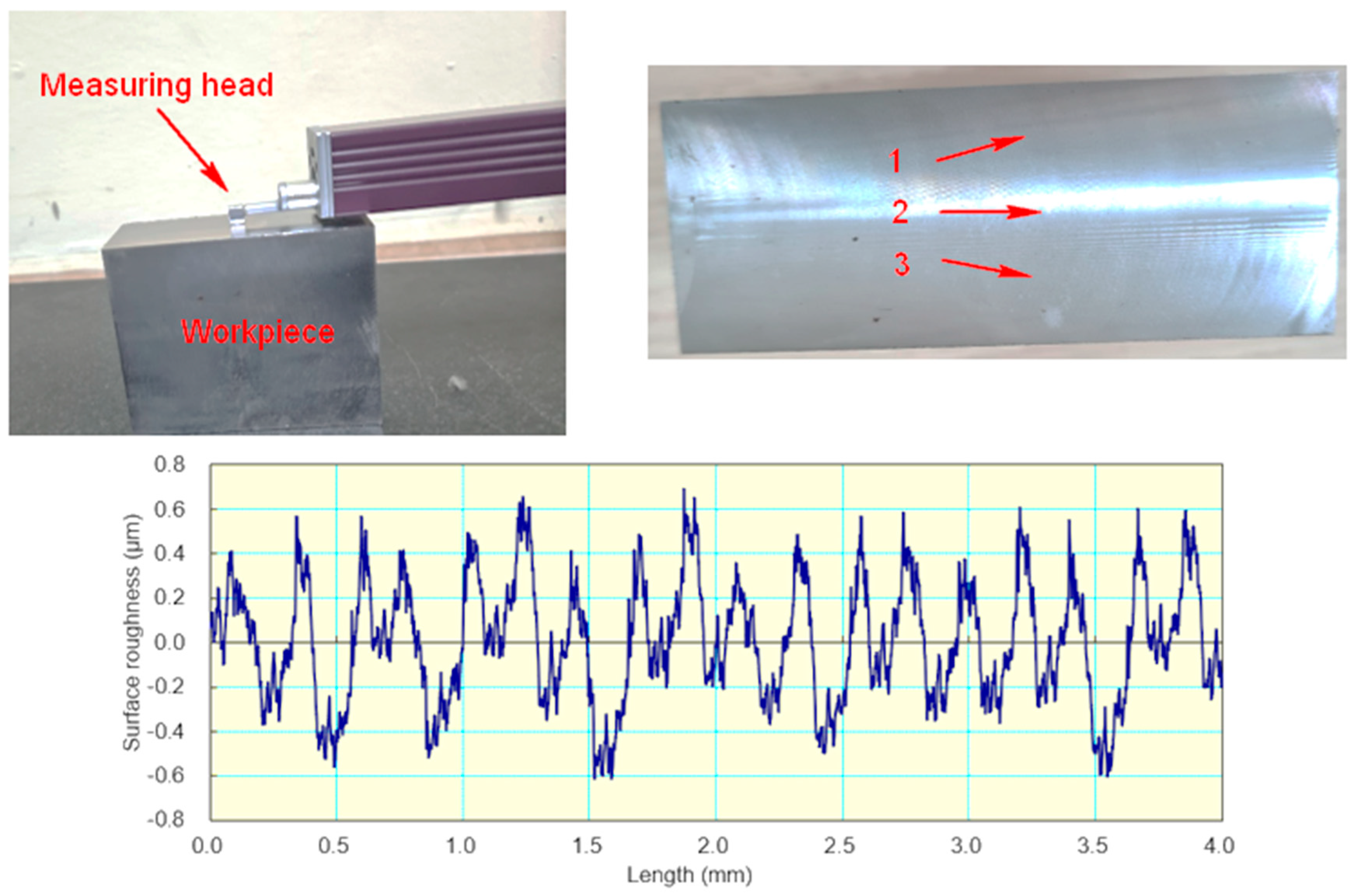
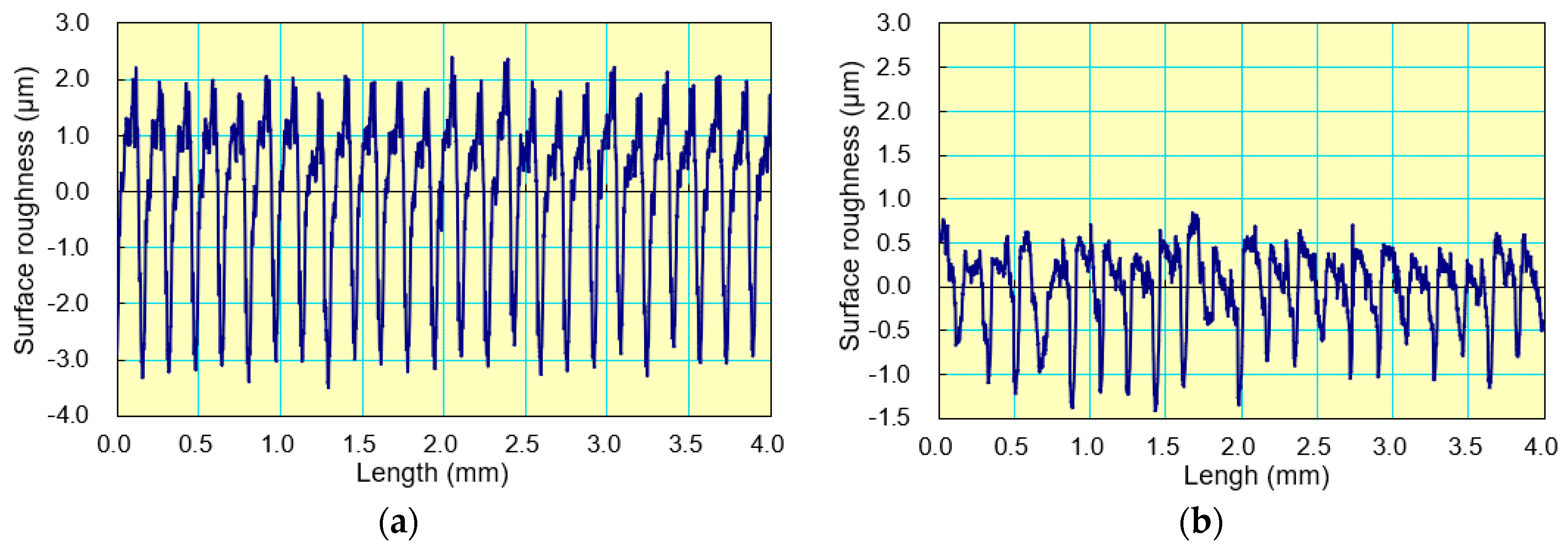
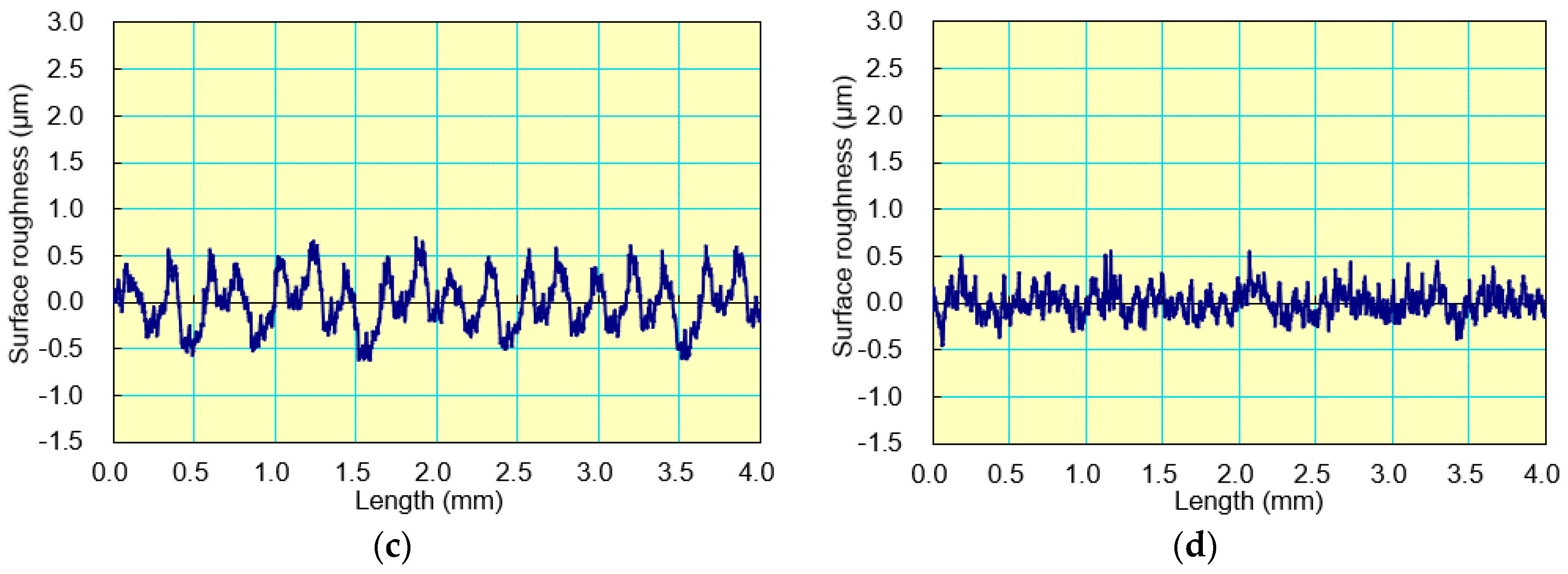
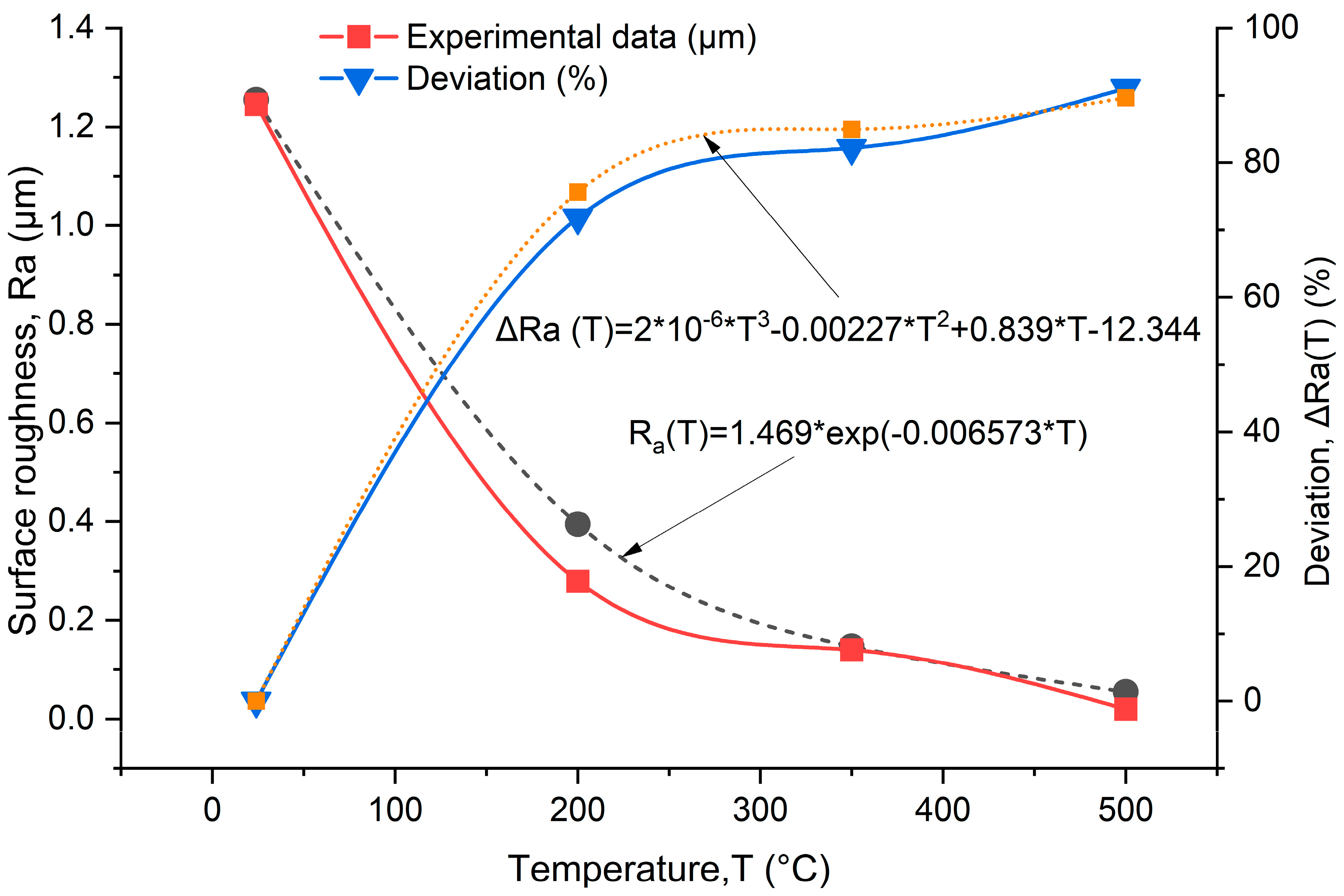
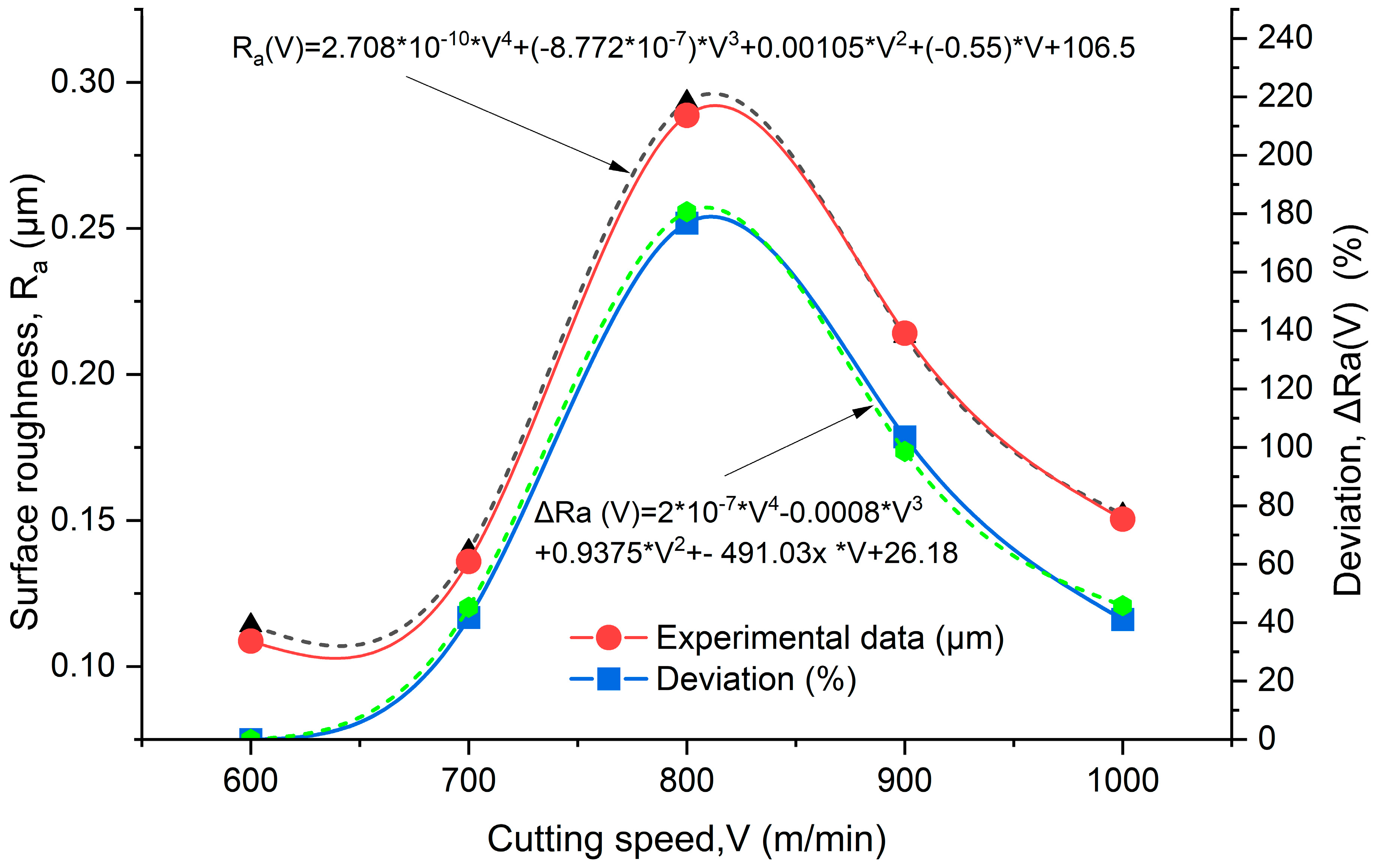
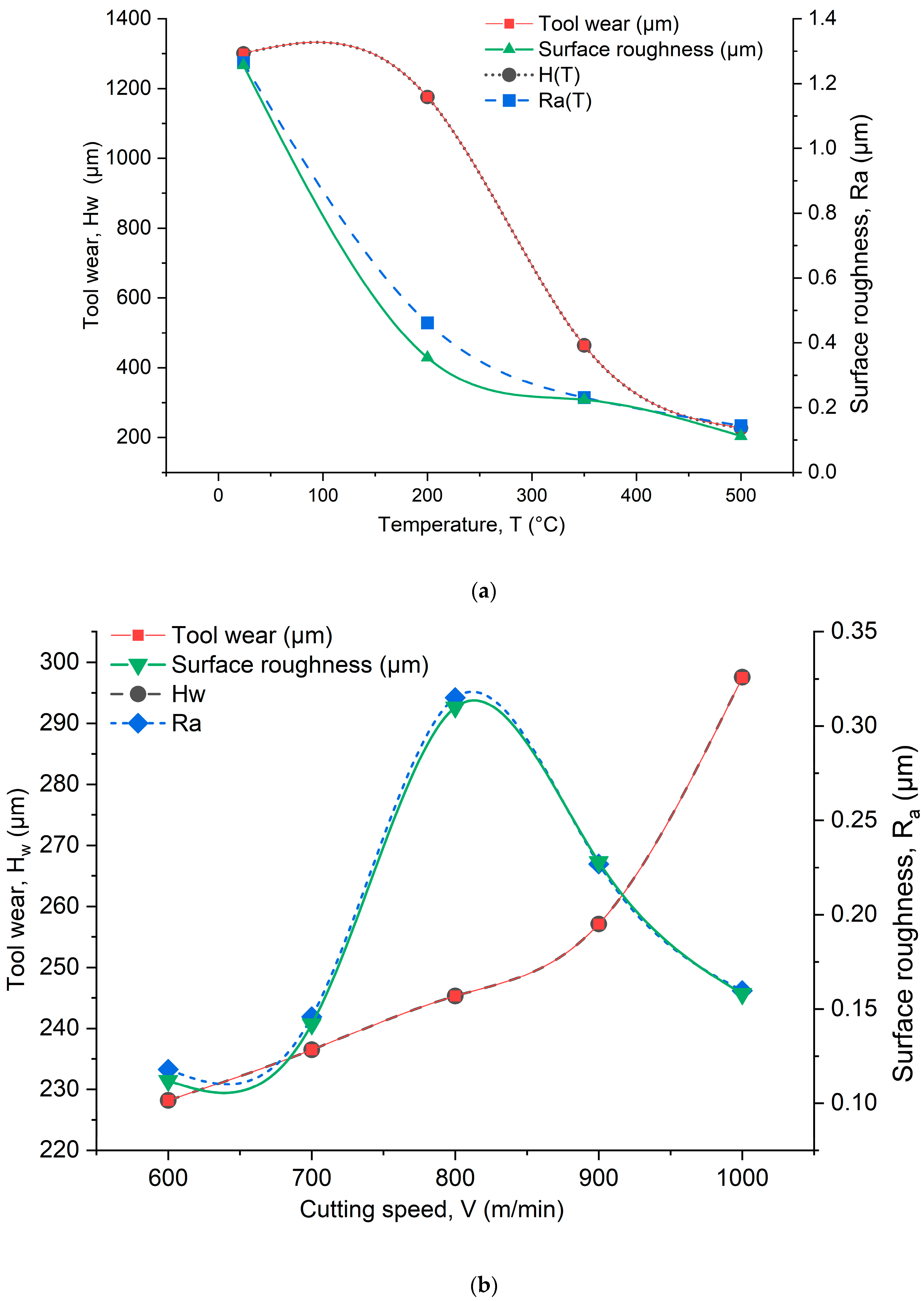
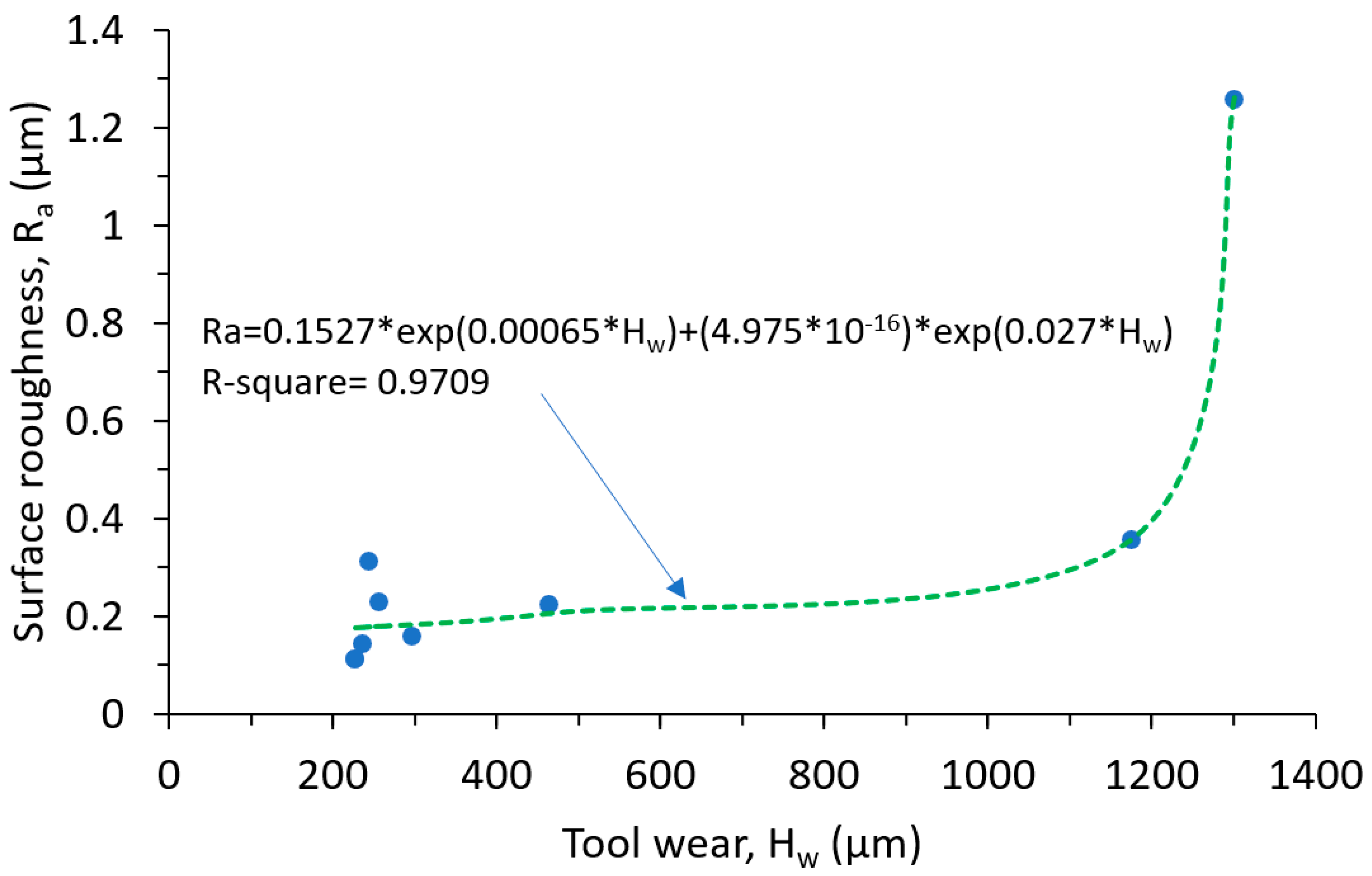
| C | Cr | Mo | Si | Mn | P | S | V |
|---|---|---|---|---|---|---|---|
| 1.42 | 11.7 | 0.83 | 0.3 | 0.41 | 0.025 | 0.0004 | 0.23 |
| Exp. No. | V (m/min) | f (mm/min) | t (mm) | T (°C) | mw (g) | Hw (µm) | Δmw-T (%) | ΔHw-T (%) |
|---|---|---|---|---|---|---|---|---|
| 1 | 600 | 802 | 1.5 | 24 | 0.047 | 1301.4 | - | - |
| 2 | 600 | 802 | 1.5 | 200 | 0.007 | 1176.0 | 85.11 | 9.64 |
| 3 | 600 | 802 | 1.5 | 350 | 0.002 | 464.2 | 95.74 | 64.33 |
| 4 | 600 | 802 | 1.5 | 500 | 0.002 | 228.2 | 95.74 | 82.47 |
| Exp. No. | V (m/min) | f (mm/min) | t (mm) | T (°C) | Hw (µm) | ΔHw (%) |
|---|---|---|---|---|---|---|
| 1 | 600 | 802 | 1.5 | 500 | 228.2 | 0 |
| 2 | 700 | 802 | 1.5 | 500 | 236.5 | 3.6 |
| 3 | 800 | 802 | 1.5 | 500 | 245.3 | 7.5 |
| 4 | 900 | 802 | 1.5 | 500 | 257.1 | 12.7 |
| 5 | 1000 | 802 | 1.5 | 500 | 297.5 | 30.4 |
| Exp. No. | V (m/min) | f (mm/min) | t (mm) | T (°C) | Ra (µm) | ΔRa (%) |
|---|---|---|---|---|---|---|
| 1 | 600 | 802 | 1.5 | 24 | 1.256 | - |
| 2 | 600 | 802 | 1.5 | 200 | 0.354 | 71.82 |
| 3 | 600 | 802 | 1.5 | 350 | 0.224 | 82.17 |
| 4 | 600 | 802 | 1.5 | 500 | 0.112 | 91.08 |
| Exp. No. | V (m/min) | f (mm/min) | t (mm) | T (°C) | Ra (µm) | ΔRa (%) |
|---|---|---|---|---|---|---|
| 15 | 600 | 802 | 1.5 | 500 | 0.112 | - |
| 16 | 700 | 802 | 1.5 | 500 | 0.142 | 26.79 |
| 17 | 800 | 802 | 1.5 | 500 | 0.31 | 176.79 |
| 18 | 900 | 802 | 1.5 | 500 | 0.228 | 103.57 |
| 19 | 1000 | 802 | 1.5 | 500 | 0.158 | 41.07 |
| V (m/min) | 600 | 600 | 600 | 600 | 700 | 800 | 900 | 1000 |
|---|---|---|---|---|---|---|---|---|
| T (°C) | 24 | 200 | 350 | 500 | 500 | 500 | 500 | 500 |
| Hw (µm) | 1301.4 | 1176 | 464.2 | 228.2 | 236.5 | 245.3 | 257.1 | 297.5 |
| Ra (µm) | 1.256 | 0.354 | 0.224 | 0.112 | 0.142 | 0.31 | 0.228 | 0.158 |
| ΔHw | - | 9.64 | 64.33 | 82.47 | 81.83 | 81.15 | 80.24 | 77.14 |
| ΔRa | - | 71.82 | 82.17 | 91.08 | 88.69 | 75.32 | 81.85 | 87.42 |
Disclaimer/Publisher’s Note: The statements, opinions and data contained in all publications are solely those of the individual author(s) and contributor(s) and not of MDPI and/or the editor(s). MDPI and/or the editor(s) disclaim responsibility for any injury to people or property resulting from any ideas, methods, instructions or products referred to in the content. |
© 2023 by the authors. Licensee MDPI, Basel, Switzerland. This article is an open access article distributed under the terms and conditions of the Creative Commons Attribution (CC BY) license (https://creativecommons.org/licenses/by/4.0/).
Share and Cite
Mac, T.-B.; Luyen, T.-T.; Nguyen, D.-T. The Impact of High-Speed and Thermal-Assisted Machining on Tool Wear and Surface Roughness during Milling of SKD11 Steel. Metals 2023, 13, 971. https://doi.org/10.3390/met13050971
Mac T-B, Luyen T-T, Nguyen D-T. The Impact of High-Speed and Thermal-Assisted Machining on Tool Wear and Surface Roughness during Milling of SKD11 Steel. Metals. 2023; 13(5):971. https://doi.org/10.3390/met13050971
Chicago/Turabian StyleMac, Thi-Bich, The-Thanh Luyen, and Duc-Toan Nguyen. 2023. "The Impact of High-Speed and Thermal-Assisted Machining on Tool Wear and Surface Roughness during Milling of SKD11 Steel" Metals 13, no. 5: 971. https://doi.org/10.3390/met13050971
APA StyleMac, T.-B., Luyen, T.-T., & Nguyen, D.-T. (2023). The Impact of High-Speed and Thermal-Assisted Machining on Tool Wear and Surface Roughness during Milling of SKD11 Steel. Metals, 13(5), 971. https://doi.org/10.3390/met13050971








